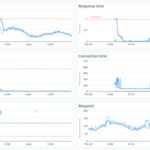First, let’s explain how the robotaxis navigate in the real world:
Robotaxis, the futuristic concept of self-driving taxis, are on the cusp of becoming a reality. While full autonomy remains on the horizon, understanding the intricate workings behind these vehicles offers a glimpse into the future of transportation. Here’s a breakdown of the key technologies enabling robotaxis to operate:
Perception System: Seeing the World Around Them
- LiDAR (Light Detection and Ranging): This sensor uses pulsating lasers to create a highly detailed 3D map of the environment, akin to a million tiny snapshots per second. It excels at detecting objects’ distance and size, making it crucial for obstacle avoidance.
- Radar (Radio Detection and Ranging): Radar emits radio waves that bounce off objects and return, providing data on their location and relative speed. It functions well in low-light conditions and through obstacles like fog, complementing LiDAR.
- Cameras: High-resolution cameras capture real-time visuals of the surroundings, allowing the system to “see” traffic lights, lane markings, pedestrians, and other vehicles.
Localization and Mapping: Knowing Where They Are
- GPS: The Global Positioning System provides a general idea of the vehicle’s location. However, its accuracy is limited for precise navigation needs.
- High-Definition (HD) Maps: These detailed digital maps, pre-loaded into the robotaxi’s system, contain information beyond basic roads. They include lane markings, traffic light locations, and even specific landmarks, allowing the vehicle to precisely locate itself within the environment.
Decision Making: The AI Brain Behind the Wheel
- Artificial Intelligence (AI): Powerful AI algorithms process the data gathered from the perception system and HD maps. This allows the robotaxi to understand its surroundings, identify potential obstacles, and plan its route in real-time.
- Machine Learning (ML): Machine learning algorithms are constantly trained on vast amounts of driving data, enabling the system to refine its decision-making and adapt to various driving scenarios.
Control Systems: Putting the Plan into Action
- Steering, Acceleration, and Braking: These systems are electronically controlled, translating the decisions made by the AI into physical actions on the road.
- Redundancy Systems: Critical systems within the robotaxi, like steering and braking, often have built-in redundancies. This ensures that even if one component fails, another can take over, prioritizing safety.
Connectivity: Staying Connected to the World
- V2X (Vehicle-to-Everything) Communication: This technology allows the robotaxi to communicate with other vehicles and infrastructure, like traffic lights. This real-time data exchange enhances situational awareness and enables cooperative driving behaviors.
These technologies work in a complex, interconnected dance. The perception system gathers data, the AI processes it, and the control systems execute the decisions. While this offers a glimpse into the workings of robotaxis, it’s important to remember that the technology is still under development. Companies are continuously refining these systems to ensure safety, reliability, and smooth operation in diverse real-world scenarios.
Tesla’s Robotaxi Strategy:
- Leveraging Existing Fleet: Unlike some companies developing dedicated self-driving vehicles, Tesla aims to utilize its existing fleet of Tesla cars equipped with their Autopilot driver-assistance system.
- Focus on Software Updates: Tesla plans to achieve full autonomy through continuous software updates to their Autopilot system. This approach hinges on the vast amount of real-world driving data collected by Tesla vehicles on the road.
- Dedicated Robotaxi Model (Potential): In April 2023, Elon Musk, Tesla’s CEO, announced plans for a future “dedicated robotaxi” model. This vehicle might lack a steering wheel and pedals, suggesting a more advanced level of autonomy compared to existing Tesla cars. However, the production timeline and specific details regarding this model remain unclear as of March 2, 2024.
Current Stage and Challenges:
- Beta Testing: Tesla’s Autopilot system is currently under beta testing with a limited number of users who opt into the program. These users provide valuable data for further development.
- Regulatory Hurdles: As with other robotaxi developers, Tesla faces regulatory hurdles regarding safety standards and clear guidelines for autonomous vehicles.
- Technical Challenges: Even with advancements, achieving true Level 5 autonomy (no human intervention required) remains a technical challenge. Tesla needs to ensure their system can handle unexpected situations and diverse road conditions.
Tesla’s approach to robotaxis is bold and ambitious. While their existing Autopilot system offers driver-assistance features, it is not yet a fully autonomous solution. Tesla’s success in the robotaxi space hinges on continuous software improvements, navigating regulatory hurdles, and overcoming remaining technical challenges.
Robotaxis operate anywhere in the world:
That depends on how you define “operate.” Here’s a breakdown of the current situation:
-
Limited Public Deployments: As of today, March 2, 2024, there are no fully autonomous robotaxis operating commercially and transporting the general public on open roads anywhere in the world.
-
Controlled Trials and Pilot Programs: Several companies are conducting trials and pilot programs for their autonomous vehicles in various locations. These programs typically involve limited geographic areas, specific routes, and often have safety drivers on board to monitor the vehicle’s performance and intervene if necessary.
Here are some examples of ongoing robotaxi trials:
* **Waymo:** Operating a limited robotaxi service in Phoenix, Arizona, and San Francisco, California (with safety drivers).
* **Cruise:** Testing self-driving vehicles in San Francisco (with safety drivers, for employees only as of April 2023).
* **Aurora:** Conducting trials in Pittsburgh, Pennsylvania, and expanding to other cities.
-
Regulatory Hurdles: One of the major obstacles to widespread robotaxi deployment is the lack of clear and comprehensive regulations governing autonomous vehicles. Governments are still grappling with safety concerns, insurance issues, and potential liability questions.
-
Technical Challenges: While self-driving technology has made significant advancements, there are still technical challenges to overcome. These include handling unexpected situations on the road, dealing with adverse weather conditions, and ensuring robust cybersecurity measures.
In the meantime,
California Approves Waymo Robotaxi Service:
There’s been a significant development! On Friday, March 2nd (just yesterday!), California’s Public Utilities Commission granted Waymo permission to operate a commercial robotaxi service in several key areas:
- Los Angeles
- San Francisco Peninsula
- San Francisco freeways
This marks a major step forward for robotaxis, potentially paving the way for the first widespread public deployment of self-driving taxis in the United States.
Previous Context Still Applies:
While this is a significant development, it’s important to remember the points we discussed earlier:
- Limited Public Deployments: Even with this approval, Waymo’s service might still have limitations initially. These could include specific operating hours, geographic restrictions, or a phased rollout process.
- Technical and Regulatory Considerations: The challenges mentioned previously regarding technical hurdles and ongoing regulatory discussions remain relevant.
This news from California is a positive sign for the future of robotaxis. It will be interesting to see how Waymo implements its service and how the public responds.
While fully autonomous robotaxis are not yet a reality for public use, the technology is constantly evolving. Ongoing trials and pilot programs are paving the way for a future where robotaxis might become a more integrated part of our transportation system.











